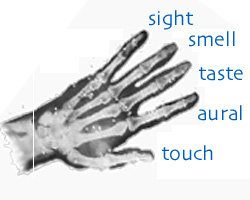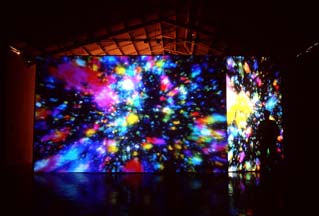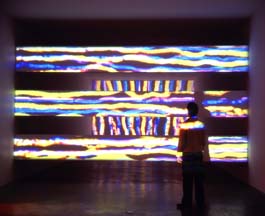

Light consists of waves of energy that excite the eye.
- The Man with the X-Ray Eyes
|
Jennifer
Steinkamp Artist Statement My Only Sunshine |
Gender Specific, 1989, 8x6, 8x6 & 10x8, 10x8 feet, (Photo courtesy
of ACME., Los Angeles). My first site-specific installation, a pair
of animations were rear projected into the windows of two sites. A spinning
polka-dot tunnel was positioned next to multiple orbiting earths. Ideas
of the feminine and masculine in architecture were playfully manipulated
in order to blur the distinctions between gender demarcations. I use light
to dematerialize space.
|
|
||
|
My artwork uses computer animation to craft immersive interactive projection installations. Three dimensional computer graphics are the basis of my abstract animation; animations which take full advantage of the computer's ability to create motion and points of view that are not available by any other means. Multiple video projectors are strategically placed in a space, and the projections of the animation are then fitted or remapped into architectural situations, the art can then be experienced physically in relationship to one's movements through the space. |
||||
|
The first installation I executed was a multiple site work titled Gender
Specific (1989), a piece created for my undergraduate thesis at Art Center
College of Design. It began as an installation for a house in Pasadena
that was an artist run alternative gallery space called Bliss, subsequently
it was also exhibited in a storefront at the Santa Monica Museum, California.
Both pieces ran simultaneously in different parts of the city and viewers
would have to drive across town to experience the entire installation.
Issues surrounding the cultural specificity of gender in relation to domestic
and consumer architecture were addressed by bifurcating the architecture
and sites across town. |
||||
|
As my ideas and the work developed, I found I could dematerialize architecture by combining light, space and movement. I had always been fascinated with the light and space artists such as James Turrel, his perceptual light illusions transform our experience of architecture. Following this tradition, I investigated how light could create an illusionistic sense of space and dimension. Unlike the light space artists, I added the component of motion to my light projected illusions that made the architecture appear to dematerialize. I first came across this visual phenomenon when I created Untitled (1993), a floor projection piece. A colorful water animation was projected from the ceiling down across the floor. The inanimate floor seemed to breathe, the architecture was transformed by light. The viewers perceived the non-physical components of the imagery and light corporealy. People actually experienced the physical sensation of seasickness. Ever since creating Untitled, I set out to investigate illusions which transform the viewers perception of actual space in a synthesis of the real and virtual. |
||||
 |
Technology |
|||
|
They are interesting because they are unpredictable; you can assign the particles a life span, tell them what color to be over their life, and attribute how they will respond to environmental variables such as gravity, turbulence and wind. You dial in these variables, and then run the simulation over night. It can be a pretty random process and it can take a couple months to complete an animation. |
||||
|
SWELL, 1995, soundtrack by Bryan Brown, 12 x 26 feet, (Photo by Joshua
White, courtesy of ACME., Los Angeles), The walls of the gallery
were huge, in response I created an underwater feeling in the space, a
virtual camera floated through a sea of multi-colored particles. The same
animation was projected twice, one horizontal, from the front, the other
vertical, from the rear. This piece taught me to consider our perceptual
relationship to physical scale. The large projections enabled the wall
surfaces to dematerialize convincingly. This piece happened to work well
with many viewers, as they could watch each other play and perform with
their shadows. The apparent solidity of both projections was disrupted
when a viewer would step in front of the rear projection.
|
Because particles were created to simulate physics, they
synthesize a very realistic quality of motion. I have long since
been interested in "life-like" motion. This is always the challenge
for an animator or anyone who thinks about motion.
|
|||
|
We recently completed a large scale piece titled Stiffs (2000). I knew almost immediately that I wanted to create large floor to ceiling monoliths, the forms would fill the space while referencing some of the existing proportions of the gallery. I imagined the monoliths as a forest of tall figures or trees. We further emphasized this by arcing the animation and sound around the viewer as they approached each monolith, the image would envelop the body. The viewer has always been an integral part of the artwork - their shadow disrupts the image, breaking the illusion of the projection. Their playfulness and movement though the space creates the experience. With Stiffs we explored spatial interactivity, using ultrasonic sensors to track the viewers relationship to each monolith. As the viewer approached the monolith, the animation would speed up. Another couple of sensors at the far ends of the gallery sent the image and sound into a chorus, all the monoliths sang together in unison. It is an interesting challenge to construct interactivity in a large space for many viewers without loosing the impact or experience of the work of art. |
||||
|
|
||||
|
Genres and Influences 3D computer graphics, virtual reality if you will,
is a new medium for artists. I find it extremely gratifying to work with
these adept tools. Works of art can be created that have never been experienced
before, although this can also be all too tempting. I feel a great responsibility
to create artwork that engenders poetic resonance. Artwork should work
on many levels, it can be accessible and interesting to an untrained audience,
as well the cultural vanguard. One of my greatest challenges is to create
a work where complex ideas can be best experienced as works of art. |
 |
|||
|
The TV Room, 1998, soundtrack by Andrew Bucksbarg, 18 x 13 x 60 feet,
(Photo by Alex Slade, courtesy of ACME., Los Angeles). I feel this
is one of my most important works to date. The installations have
become more architectural since this piece. We built three wall
strips stretched horizontally across the gallery of the museum.
|
||||
| back to top | ||||